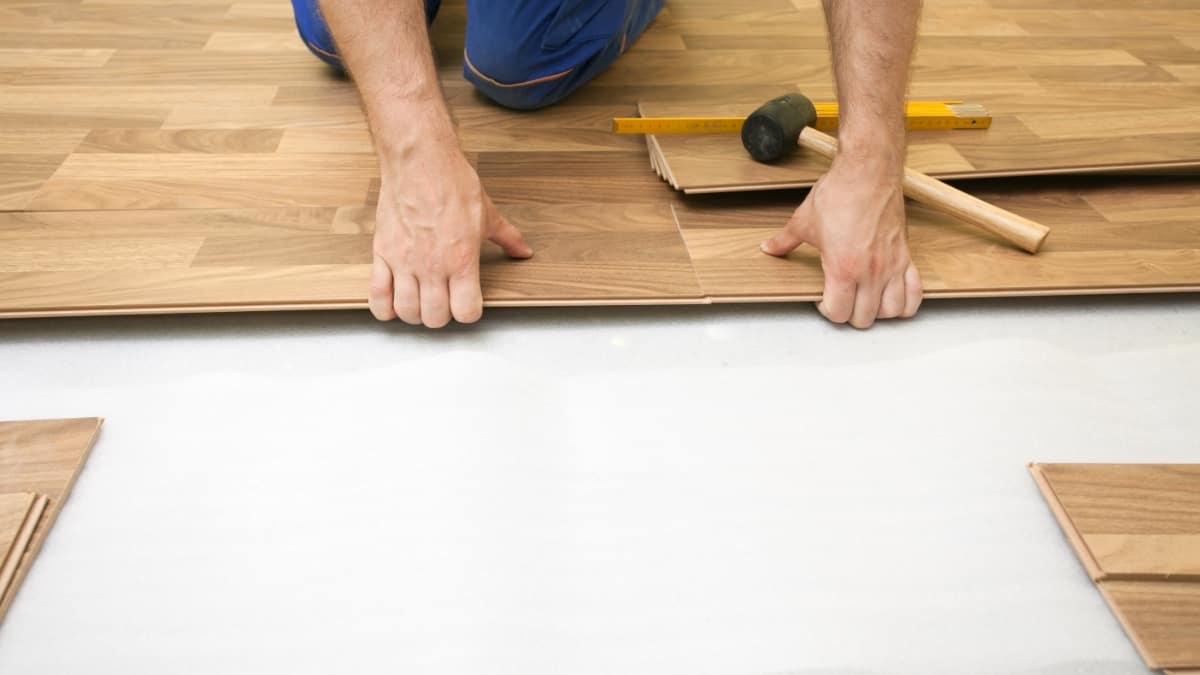This post contains affiliate links.
Laminate flooring has been one of the go-to hardwood floor alternatives because it’s cheap, it’s DIY friendly, it has better scratch resistance than hardwood, and it’s relatively easy to clean and maintain. You can install laminate on your own, even if you’re a complete beginner. Although it looks like wood, how you install it is very much different from how you do it with wood floors. If wood floors are nailed or glued down to the sub-floor, then how do you put down laminate flooring?
Can you nail down laminate flooring? Laminate is designed as a floating floor, and as such, should not be fixed to the sub-floor. It will naturally contract and expand to changes in humidity and nailing it down will disrupt this. This can damage the integrity of the floor and generate problems, such as floor peaking, in the future.
How about gluing it down? Can you glue down laminate flooring? Gluing down laminate to the sub-floor is not advisable. Since laminate is designed as a floating floor and is meant to contract and expand naturally, gluing it down will disrupt this process. The only exception is when you’re installing it on stairs wherein the laminate should be fixed to the steps.
With the exception of stairs installation, there is only one way to put down and installing laminate flooring to any room and that is to just lay it flat, over an underlayment, without any adhesives or nails, onto the sub-floor. There are of course some preparations that should still be done and requirements that should also be met during the installation process.
What Happens if You Nail, Screw, or Glue Down Laminate Flooring?
As mentioned above, laminate flooring is designed as a floating floor, and as such, should be allowed to move freely. It’s made with a fiberboard core that gives the laminate planks its stability and support. Laminate planks thickness typically ranges between 6 and 12mm but some manufacturers have thicker options. Although its core is not as strong as hardwood floors, this is one of the reasons why they can keep the costs down.
Having a fiberboard core, laminate flooring is sensitive to moisture and will react to changes in moisture content and humidity in its environment. It will naturally expand and contract as it adjusts to the humidity and moisture levels of the room. This is why it is important to acclimate laminate before installation so that it normalizes to the normal conditions of a room. You can read more about acclimating laminate flooring in this article.
The natural expansion and contraction of laminate flooring is also the reason why an expansion gap is provided at its edges. This allows the laminate enough room to move freely as it adjusts to the changes in humidity.
If you nail down or glue down laminate flooring to the sub-floor, you will disrupt its natural process of expansion and contraction. Fixing it to the sub-floor will eventually lead it to accumulate damages and it will not last as long as it should be. Nailing, screwing, or gluing it down will also void the warranty of the product.
Below are some of the possible problems you’ll encounter if you nail, screw, or glue down laminate flooring:
1. Laminate Floor Peaking
Peaking happens in laminate flooring when its floorboards push against one another creating pinching and high points in some areas of the floor. This normally happens if the laminate floor was not provided enough expansion gap around the room, and its edges push against the walls as it tries to expand. This can also happen if parts of the floor are fixed, such as if you nail, screw, or glue it down to the sub-floor.
If any part of the floor is fixed, as it tries to expand as humidity levels of the room increases, it will push against the fixed part of the floor and will eventually lift up. This can eventually lead to joint failures or permanent buckling and warping of the floor.
2. Laminate Floor Gapping
Gapping usually happens when the temperature and humidity of the room drops down considerably which forces the laminate floor planks to pull away at their joints creating unsightly gaps. Although this doesn’t normally happen, if you nail, screw, or glue down laminate flooring to the sub-floor, it is a possibility. Fixing parts or the whole laminate floor will not allow it to move as a whole unit and it can separate at the joints as each planks adjusts or contracts when humidity levels goes down.
3. Laminate Floor Chipping
Possible chipping may occur where the nails or screws were placed. Because of the underlayment, laminate floors flexes and have a bit of a give when walk on. The nails or screws will eventually become exposed as you walk on the floor, and the laminate flexes.
As the laminate naturally expands and contracts, and as it moves and flexes when walked on, it will eventually start to chip around the nail or screw holes. As the holes become bigger, the chipping and damage on the floor can travel to the other parts which can eventually compromise the stability of the floor and integrity of the joints.
When to Use Glue on Laminate Planks
Glue is actually sometimes used on laminate planks but not to fix it to the sub-floor, but to attach the planks to one another, by their tongue and groove members. This is usually done in areas that are prone to high moisture levels, or areas that are exposed to water. It helps make the surface more water resistant, and the glue will act as an extra barrier to prevent moisture from penetrating into the floor’s core.
In normal circumstances though, glue is not recommended to use.
When installing laminate on stairs, it is also normally glued down. since each step usually requires 1 or at most 2 laminate planks, gluing it down will not have any negative impact as when you glue it down to a larger surface area.
Quick Steps on How to Properly Install Laminate Flooring
Here’s a short set of instructions on how you to properly install laminate flooring:
Step 1. Acclimate the Laminate Flooring
Acclimating laminate floors is a necessary step to ensure that the laminate normalizes itself to the normal conditions of the room. You can learn more about acclimating laminate floors in this article.
Here’s also a video showing how you could do it:
Step 2. Check the Sub-floor and Address Any Issues
Laminate floors should be laid on a flat, and relatively smooth sub-floor. Any imperfections like areas that are dipping or peaking should be corrected by filling-in the holes, or sanding down high points, to make the surface flat and smooth for the laminate floor to lay on.
Step 3. Prepare all the Tools and Materials
The basic tools you’ll need is a rubber mallet or hammer, utility knife, tape measure, pencil or marker, straight-edge, gap spacers, tapping-block and pull Bar, and a table saw or handsaw.
Step 4. Clean, and Vacuum the Area Prior to Installation
Make sure the work area is clean before and during the installation. Any dust, dirt or debris that are left underneath the laminate may produce crunching sounds when you walk on the floor.
Step 5. Decide on Which Direction the Laminate Flooring Will Run and the Pattern It Will Follow
There is really no right or wrong direction as to how to lay the laminate flooring. You can go for what you feel is right. What some installers do is to follow the direction of the longer side of the room. Just make sure to stagger the placements of the planks, and that no two planks that are side by side have their shorts ends line up.
Step 6. Roll Out the Underlayment
If the laminate floor you’re using already has a built-in underpad underneath it, you don’t need to lay down a separate underlayment anymore. Otherwise, lay down one layer of underlayment across the sub-floor surface. Make sure that there are no overlapping parts and that they meet exactly edge to edge. And then tape them down or stick them together.
Step 7. Lay Down the First Row of Laminate Planks
Based on the direction layout of the laminate you’ve decided in step 5, start laying down the first row. Normally, you start each row from the right going towards the left.
For the first row of planks, you need to cut their tongues with a utility knife or any of your cutting tool. This side of the plank will be the side that faces the wall. As you lay down the first row, use the gap spacers to create a constant gap between the laminate and the wall.
Step 8. Continue Laying Down the Rest of the Planks, Row per Row, Following the Pattern You’ve Decided in Step 5
Following the layout pattern you’ve decided to go for in step 5, continue laying down the rest of the planks. Make sure you maintain a constant expansion gap around the room, between the edges of the laminate and the walls.
Step 9. Install Moldings Over the Expansion Gaps
As soon as you finish installing all the laminate, it’s time to install the molding, usually a shoe or half round molding, to cover the expansion gap between the edge of the laminate and the wall.
When installing the molding, make sure you do not nail down the laminate in the process.
Step 10. Install Transition Strips Where Laminate Meets Another Floor
Provide transition strips, normally located at doorways, where the laminate meets another floor.
Step 11. Add Caulking to Fill-in Gaps Between the Floor, Molding, and Trim Connections
To make everything neat and clean, you can add caulking to fill-in gaps at corners of the floor, molding, and trim.
Here’s a good video demonstrating how to install laminate flooring for beginners:
All About Materials is a participant in the Amazon Services LLC Associates Program, an affiliate advertising program designed to provide a means for sites to earn advertising fees by advertising and linking to Amazon.com. We also participate in other affiliate programs which compensate us for referring traffic.

